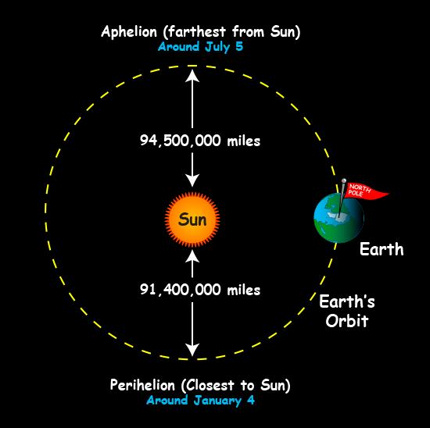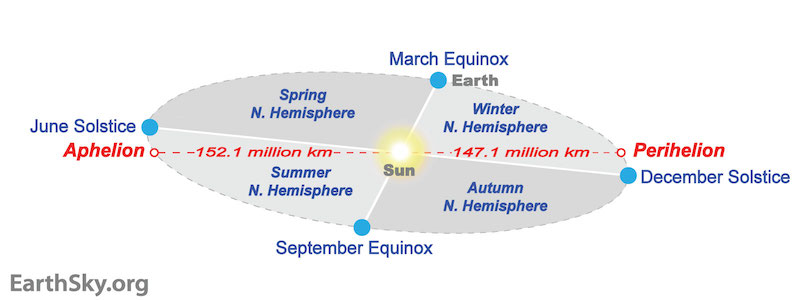
Earth at perihelion in January
Earth’s orbit around the sun isn’t a circle. Instead, it’s an ellipse, like a circle someone sat down on. So, it makes sense that Earth has closest and farthest points from the sun each year. For 2023, our closest point comes at 16 UTC (10 a.m. CST) on January 4 … This is the morning in North America. This closest Earth-sun distance is called perihelion, from the Greek roots peri meaning near and helios meaning sun. In early January, we’re about 3% closer to the sun – roughly 3 million miles (5 million km) – than we are during Earth’s aphelion (farthest point) in early July. That’s in contrast to our average distance of about 93 million miles (150 million km).
NASA Earth Fact Sheet with precise perihelion and aphelion distances.
So, Earth is closest to the sun every year in early January, when it’s winter for the Northern Hemisphere.
And we’re farthest away from the sun in early July, during our Northern Hemisphere summer.
Clearly, Earth’s distance from the sun isn’t the cause of the seasons.
Earth’s orbit doesn’t cause seasons
So, Earth’s orbit isn’t a circle. But it’s nearly circular. And it’s not our distance from the sun that creates winter and summer on Earth. Instead, the tilt of our world’s axis with respect to our orbit causes seasons.
In winter, your part of Earth is tilted away from the sun. In summer, your part of Earth is tilted toward the sun. The day of maximum tilt toward or away from the sun is the December or June solstice.
The tilt changes the angle of sunlight falling on your part of Earth. More direct sunlight = summer. Less direct sunlight = winter.

Earth’s orbit affects length of the seasons
Though not responsible for the seasons, Earth’s closest and farthest points to the sun do affect seasonal lengths. When the Earth comes closest to the sun for the year, as we do every year in early January, our world is moving fastest in orbit. Earth is rushing along now at almost 19 miles per second (30.3 km/sec), moving about 0.6 miles per second (one km/sec) faster than when Earth is farthest from the sun in early July. So the Northern Hemisphere winter and – simultaneously – the Southern Hemisphere summer are the shortest seasons, as Earth rushes from the solstice in December to the equinox in March.
In the Northern Hemisphere, the summer season (June solstice to September equinox) lasts nearly five days longer than our winter season. And this holds true for the corresponding seasons in the Southern Hemisphere, as well. Southern Hemisphere winter is nearly five days longer than Southern Hemisphere summer.
The 30-second YouTube video below illustrates how a planetary body speeds up around perihelion and slows down at aphelion. It’s due to Kepler’s second law of planetary motion: a line connecting the sun and a planet sweeps out equal areas in equal times.

Bottom line: In 2023, Earth’s perihelion, its closest point to the sun, is on January 4 at 16 UTC.
The post Earth closest to sun on January 4 first appeared on EarthSky.
0 Commentaires